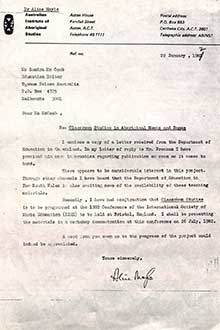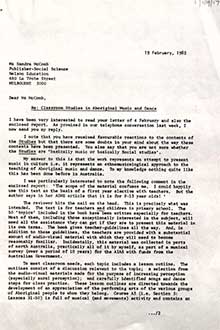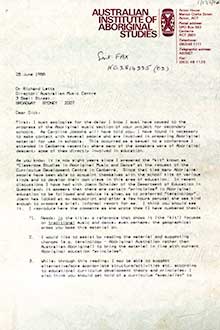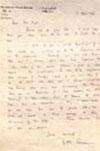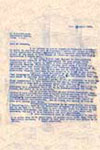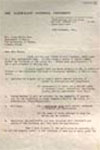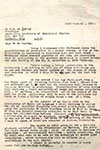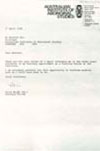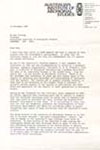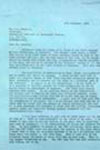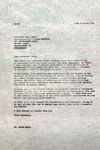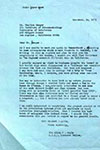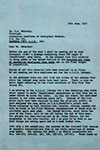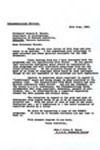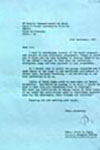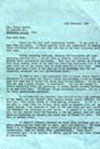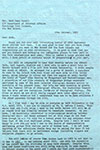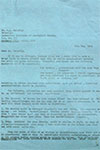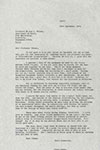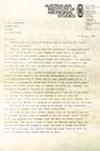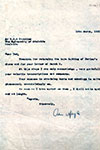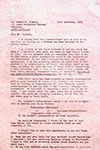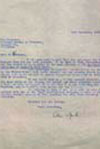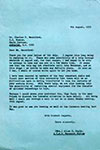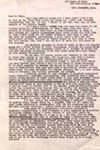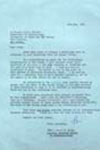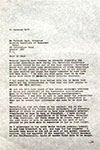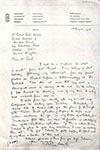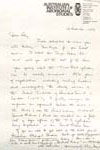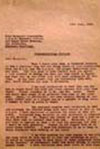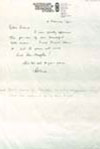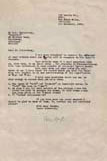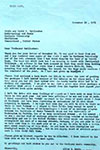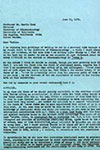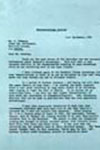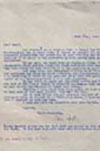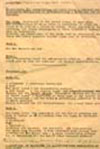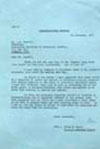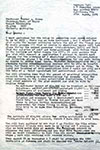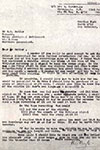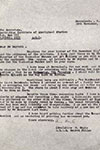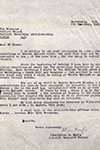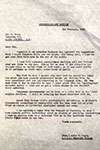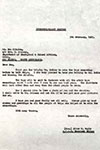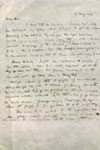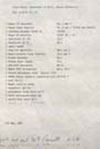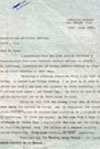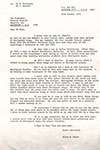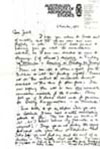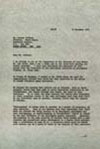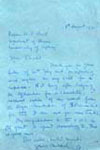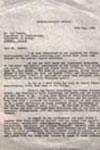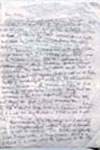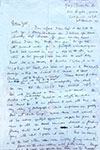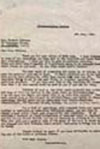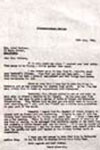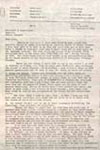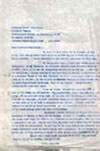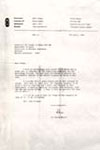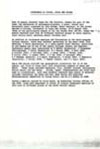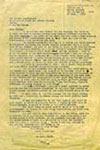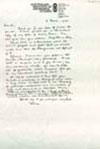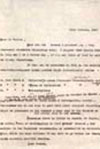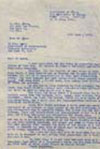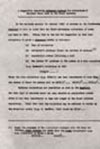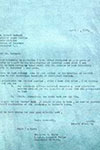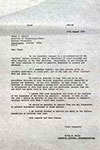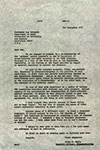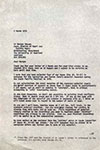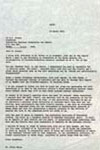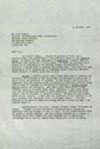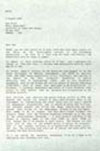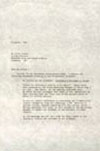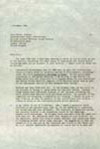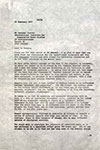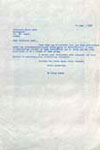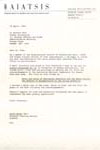Aboriginal Music Kit
In 1980 the Curriculum Development Centre in Canberra approached Alice about creating an audiovisual kit on Australian Aboriginal music. The publication, which took eleven years to complete, was issued by Monash University in 1991 as a resource kit, Music and dance in traditional Aboriginal culture. These letters trace the lengthy process of publication.
To Sandra McComb, Education Editor, Thomas Nelson Publishers, 22/01/82 Shows the kind of demand arising for the kit and requests information on its progress. (MS3501/1/109/8).
To Sandra McComb, Education Editor, Thomas Nelson Publishers, 19/02/82 Describes what sort of modifications would be acceptable and shows concern over the progress of the publication. This situation highlights the general lack of awareness amongst the general Australian education community about Aboriginal cultures and how to include Aboriginal material in the curriculum. Alice hoped to provide a positive example of how to study aspects of Aboriginal music by this kit. (MS3501/109/17).
To Richard Letts, Director, Australian Music Centre, 28/06/88 Provides brief history and report on the progress of the kit, including a copy of the assessment made by an Aboriginal reviewer at the Department of Education in Queensland. This letter represents a real shift in the sociopolitical landscape with Alice now having her work critiqued and advised by Aboriginal specialists in the field of primary and secondary education. (MS3501/1/135/14).
AIAS Connections
Alice held research positions with the Australian Institute of Aboriginal and Torres Strait Islander Studies (AIATSIS) for over 30 years. When she began her affiliation with the Institute, it was known as the Australian Institute of Aboriginal Studies (AIAS), but when its new Act was passed in 1989, its title included reference to Torres Strait Islanders. These letters give some background information on her first involvement with the Institute and contain examples of her administrative work.
From W.E.H. Stanner, Chair, 1961 Conference on Aboriginal Studies, 03/04/61. Confirms his earlier invitation to Alice to attend the conference held in May 1961 that set the directions for the proposed AIAS. (MS3501/1/7/29).
Click here for transcript of letter.
To W.E.H. Stanner, Department of Anthropology, Australian National University, 21/11/61. Requests advice in applying for financial assistance for her work, mentioning her plans to pursue further study towards a PhD. (MS3501/1/9/44).
From W.E.H. Stanner, Department of Anthropology, Australian National University, 28/11/61. Advises Alice to apply to the AIAS for a grant for further research and outlines some of the issues involved in working on a PhD through the Australian National University. (MS3501/1/9/47).
To W.E.H. Stanner, Executive Officer, AIAS, 04/12/61. Submits application for a research grant to continue study on Australian Aboriginal music and outlines work plans for the next few years. (MS3501/1/9/52).
To J.S. Boydell, Secretary, AIAS, 03/06/66. Thanks for notification of appointment to the AIAS Advisory Committee on Ethnomusicology. (MS3501/1/22/3).
To F.D. McCarthy, Principal, AIAS, 23/3/67. Seeks approval to make a formal application to Monash University in order to pursue studies towards a PhD. Alice describes her research plans, assuring him that her work for the AIAS as a Research Fellow will continue. (MS3501/1/26/15).
To W.C. Wentworth, Minister for Social Services, Parliament House, 14/01/72. Thanks for information on Ray Price’s tour of Australia. After some comments on her own overseas study, she gently emphasises the uniqueness of Australian Aboriginal music. (MS3501/1/60/23).
To Warwick Dix, Principal, AIAS, 14/01/72. Thanks for extending her Fellowship. Alice maintained her formal connections to AIATSIS until 1995. (MS3501/1/127/30).
To Ken Colbung, Chair, AIAS, 19/11/87. Responds to a Review of a government proposal that would have radically changed the operations of Aboriginal agencies, including the AIAS. The Review, entitled ‘Foundations for the Future’, was commissioned by Gerry Hand, who was the Minister for Aboriginal Affairs in 1987. (MS3501/1/133/6).
AIAS Sound Archive
As the guiding spirit of the AIAS Recorded Sound Archive, Alice set principles and procedures for the cataloguing and preservation of its holdings. Her own field tapes had been edited onto a series of 5 inch reels with each song separated by audio pips for easy retrieval. This method of arrangement made it easy for her to edit her first set of published field recordings, the five-volume set, Songs from the Northern Territory. These letters specify how she wanted her collection to be handled and give guidelines for the arrangement and description of other field tapes.
To F.D. McCarthy, Principal, AIAS, 27/11/68. Explains how Alice envisages the care and handling of her recorded sound collection upon its transfer to AIAS in Canberra. (MS3501/1/40/33). See also F.D.McCarthy Manuscript Finding Aid
To Warwick Dix, Principal, AIAS, 16/12/85. Outlines plans for security lodgement of copies of the N.B. Tindale audio collection at AIAS. This work was completed in 1986. (MS3501/1/126/16).
Alice Moyle Recordings
These two letters give some idea as to Alice’s prodigious output of published recordings and show some of her hopes for increasing ethnomusicological work in Australia and the Pacific.
To Wolfgang Laade, Lawley House, Barton, 19/09/66. Gives an insight into how Alice valued sound recordings and states some of her hopes for increasing ethnomusicological work in Australia and the Pacific. The letter was written just after Laade had completed his field work in Torres Strait. (MS3501/1/24/22).
To Hans Oesch, Musikwissenschaffliches Institut der Universität Basel, 10/12/80. Discusses the sound recordings made by Alice and shows how she would structure a contribution to his series of recordings, Der Musik Ozeaniens. (MS3501/1/104/21).
Computer Projects
Alice explored computerised applications for music analysis and for cataloguing purposes. These letters refer to two major projects; one with the New York based Griphos scheme for classifying music styles and the other for creating a database of Aboriginal song words from early sources.
To Charles Seeger, Institute of Ethnomusicology, University of California at Los Angeles, 20/12/71. Gives details of Alice’s travels and comments on a project that she saw at the Musee de l’Homme in Paris that was somewhat similar to Seeger's melogram, which performed instrumental analysis of non-Western music. (MS3501/1/104/21).
To Benjamin Suchoff, Curator of Béla Bartók Archives, New York, 23/11/67. Seeks information on procedures used by Suchoff to encode music into the Griphos System. In 1967 a consortium of New York City museums developed a computer cataloguing system called Griphos for objects in the hope of creating a union catalogue for their holdings. Benjamin Suchoff had extended the coding systems of Griphos to provide an analysis of Rumanian folk music material, and Alice hoped to adapt it to Australian Aboriginal music. (MS3501/1/32/33).
To Benjamin Suchoff, Curator of Béla Bartók Archives, New York, 02/02/68 . Acknowledges Suchoff’s answer to her request for information in 1967, and demonstrates her interest in computer applications for the analysis of Aboriginal music. Later Alice produced a number of coding sheets, referring them to Suchoff for comment. This work influenced the classification and cataloguing systems for music that she designed for the Computerised Index of Aboriginal Music, Area ‘Y’, which describes the collection of sound recordings from Cape York held at the AIAS (now AIATSIS). The letter refers to the 'N area' which covers Arnhem Land and goes south to Daly Waters; this was Alice's major research region. This letter shows her concern about the effects of popular music upon traditional Aboriginal music, referring to such influences as 'contamination'.
To F.D. McCarthy, Principal, AIAS, 29/06/72. Describes the aims for a project to compile a listing of song words from early sources and to make them available via computer. The project, completed in 1973, was drawn from sources ranging from 1798 to the 1970s that are held at AIATSIS and State libraries. A printout of the project is available in the AIATSIS Library under the title, 'Computerised Index of Aboriginal Song Words'.
Copyright
Alice always respected the rights of Australian Aboriginal people to their own cultural property, and ensured that they receive proper attribution. These letters state her views on the topic.
To Ronald M. Berndt, Department of Anthropology, University of Western Australia, 20/06/66. Explains Alice’s position towards respecting the rights of Indigenous people and ensuring that their permission be sought if copies of recordings were to be made. (MS3501/1/22/39a).
To Rosario Sanchez-Guerra de Garza, Radio & Visual Information Division, Unesco, 23/09/61. Emphasises the importance of dissemination to the traditional owners, demonstrating through her questions the intricate nature of copyright. (MS3501/1/9/26).
Dance Interest
Aboriginal dance and music are inextricably linked and Alice made her first forays into filming because of this. These letters describe her experiences filming with synchronised sound at Groote Eylandt in 1969.
To Mrs. Victor Carell (Beth Dean), Northmead, NSW, 13/02/69. Describes characteristics of Aboriginal dance from north Australia, asking for advice on dance notation. Beth Dean was the choreologist and performer who had choreographed the dance for John Antill’s musical ballet, Corroboree. This letter also makes an interesting comment on the influx of tourists and the reaction of the local Aboriginal people to tourism. (MS3501/1/43/20a).
To F.D. McCarthy, Principal, AIAS, 15/05/69. Gives the rationale for her project funded by the Elizabethan Theatre Trust to film and analyse Aboriginal dance at Groote Eylandt with the choreologist, Elphine Mostert (nee Allen) (MS3501/1/45/14).
To Beth Dean, c/o Department of Internal Affairs, Rarotonga, Cook Islands, 14/10/69. Shares Alice’s experiences about filming music and dance at Groote Eylandt in 1969, observing some of the changes she had witnessed during her field trips there through the years. Some of the films made as part of the project can be found in the AIATSIS Audiovisual Archive under the titles, 'Music and Dance in Groote Eylandt', 'MOSTERT_VIDEO_01', and 'Groote Eylandt 8.4- Five Brolga Dances.' (MS3501/1/47/48).
To Darius Thieme, Department of Music, Fisk University, USA 28/09/73. Explains the process Alice used to plan the Groote Eylandt field project in 1969 where she collaborated with a dance notationist and a film crew. In this letter, Alice refers to the films, 'Groote Eylandt 8.4- Five Brolga Dances' and related items held in the AIATSIS Audiovisual Archive. Professor Darius Thieme, ethnomusicologist and music educator,had asked Alice for information about her project that used various forms of documentary notation. Fisk is one of the most distinguished African-American universities in the United States. (MS3501/1/68/58).
Didjeridu
Alice’s dissertation contained much information on Australian Aboriginal instruments. These two examples of her letters about the didjeridu give valuable information based upon earlier articles she had written.
To W.C. Wentworth, Kuranda, Qld., 02/02/89. Responds to his query about connections between early European instruments and the didjeridu. Her letter draws upon information in her article, ‘The Australian didjeridu : a late musical intrusion’ in World Archaeology - 1981; 12(3); 321-331. (MS3501/1/138/16).
To Graham Wiggins, Abingdon, England, 01/05/89. Acknowledges his work on physics and the didjeridu, and passes on her best wishes. (MS3501/1/139/8a).
Early Recordings of Aboriginal Music
Alice made a great contribution to the AIAS Recorded Sound Archive by locating early recordings and securing copies. This series of letters illustrates her successful attempts to get copies from many distinguished scholars and organisations.
To Mr Lawton, Department of Music, University of Adelaide, 09/10/57. Shows the beginnings of Alice’s project to make microgroove disc copies of the cylinder recordings made by W. Baldwin Spencer and Frank Gillen in 1901 and 1912. (MS3510/1/3/30).
To T.G.H. Strehlow, University of Adelaide, 16/03/61. Thanks Strehlow for his work, especially for transcribing the texts of E.Harold.Davies’ recordings of songs made with Arrernte people and others in the late 1920s. (MS3501/1/7/22).
To Norman B. Tindale, South Australian Museum, Adelaide, 12/09/72. Shows some of the breadth of Alice’s research, both for the content of recordings and for their preservation. Here she discusses Terry M. Crowley's transcription of song words as sung by the granddaughters of Fanny Cochrane Smith. This letter can be linked to 1/126/16, where she puts forth a plan for the preservation of Tindale’s recordings. (MS3501/1/64/28).
To W.E.H. Stanner, Department of Anthropology, Australian National University, 29/03/61. Describes her past studies and tells of her hopes to produce a number of disc recordings of early Australian Aboriginal music. (MS3501/1/7/26a).
To C.W. Brazenor, Director, National Museum of Victoria, 29/11/61. Shows Alice’s excitement about the copyright being granted for publication of a disc of the W. Baldwin Spencer recordings. She voices her hopes that it will be listed in the Unesco International Catalogue of Recorded Folk Music. (MS3501/1/9/49).
To Arthur Capell, Department of Anthropology, The University of Sydney, 07/06/66. Sends some examples of song texts Alice had located in early sources from New South Wales. The references are to Bennelong and Yammowey on their visit to England (early 1800's), women of the Menero/Monaro people of the Cooma region, and Narrinyeri people (1860 and 1893). Arthur Capell was one of the pioneers in the field of Australian Aboriginal linguistics. (MS3501/1/22/11).
To Murray Barrett, Dental School, University of Adelaide, 29/11/67. Asks for copies of the W. Baldwin Spencer wax cylinder recordings held at the University of Adelaide and offers some advice for repair. (MS3501/1/32/46).
To C.P. Mountford, South Australian Museum, Adelaide, 04/08/72. Ensures that the transfer to tape of Mountford’s audio recordings from his expeditions to Aboriginal communities throughout Australia will be handled most competently. (MS3501/1/63/30).
Early Recordings of Pacific Music
Early in her career, Alice had considered studying the music of Papua New Guinea. Although she never lost her interest in the area, her research focus moved to Australian Aboriginal music. These letters provide much information about Pacific song styles.
To Ralph Bulmer, Department of Anthropology, Australian National University, 13/10/56. Shows Alice’s interest in the music of New Guinea. She contacted Bulmer while she was still a Teaching Assistant at the University of Sydney. (MS3501/1/2/37).
To Ralph Bulmer, 1/12/59. Response to Bulmer’s letter about his field experiences, commenting on tape recorders. (MS3501/1/5/73).
To Allen Harry Hall, 29/11/60. Offers a broad classification of music from the Solomon Islands based upon the information sent to Alice from Allen Harry Hall, who had been a missionary there and had collected recordings of songs. There are also references to ethnomusicological method and to Alice’s taste in music. (MS3501/1/6/76).
To Stephen Wurm, Department of Linguistics, Research School of Pacific Studies, Australian National University, 27/03/61. Explores the possibility of bringing out an L.P. disc of music from the New Guinea Highlands. (MS3501/1/7/24).
To Allen Harry Hall, Goldie College, British Solomons, 21/04/61. Informs Hall how Alice has made use of the recordings he sent to her, emphasising her interest in Melanesian music. (MS3501/1/7/39).
To Ralph Bulmer, Department of Anthropology, University of Papua and New Guinea, 21/04/61. Explanation about Alice’s research focus moving towards Australian Aboriginal music. (MS3501/1/36/60).
Early Recordings of Torres Strait Islander Music
The first ethnographic recordings made in Australia were the wax cylinders of the Cambridge Expedition to the Torres Strait in 1898 led by A.C. Haddon. These letters show part of the saga of Alice’s search for the cylinders in London and arranging for copies. The first audio recordings made in Australia were the wax cylinders of the Cambridge Expedition to the Torres Strait in 1898 led by A.C. Haddon. These letters show part of the saga of Alice's search for the cylinders in London and arranging for copies.
To Patrick Saul, Director, British Institute of Recorded Sound, London, 21/10/77. Proposes a method to transfer the wax cylinder recordings from the 1898 Cambridge Expedition to the Torres Strait to tape as a project in conjunction with the Deutsches Rundfunkarchiv (German Radio Archive in Frankfurt.) (MS3501/1/91/41).
To Patrick Saul, Director, British Institute of Recorded Sound, London, 01/08/78. Request for information about the progress of the transfer of the Cambridge Expedition cylinders to tape. Written near the time of her retirement from the AIAS, Alice shows her dedication to the care and preservation of early recorded sound material. (MS3501/1/97/1).
To Alan Ward, Archive Administrator, The British National Sound Archive, London, 19/12/84. Describes how Alice auditioned and documented the Cambridge Expedition cylinder recordings. Also, it advises him on choosing conditions of access and copying for deposit at AIAS. The British Institute of Recorded Sound, which had held the Cambridge Expedition cylinder recordings, transferred its holdings to the British Library National Sound Archive in 1983. Islands visited on this expedition were Murray (Mer), Mabuiag, Saibai and Yam. recordings were also made outside the Torres Strait in Borneo and Papua New Guinea. (MS3501/1/122/34).
To Alan Ward, Archive Administrator,British Library National Sound Archive, London, 22/05/85. This letter follows on from the letter to Alan Ward of 19/12/84 and gives further information about possible missing cylinder recordings in the Cambridge Expedition recordings and follows on from letter MS3501/1/122/34. (MS3501/1/124/19).
To Ray Keogh, [University of Sydney], 14/11/86. Answers a query about the Cambridge Expedition cylindersand gives some insights into how Alice located them in London. In 1986, Ray Keogh was a PhD student in ethnomusicology at the University of Sydney who worked on Aboriginal music of the Broome area. (MS3501/1/129/18).
Ethnomusicology Research
Alice maintained a large network of contacts, both nationally and internationally, amongst ethnomusicologists and researchers in related disciplines. This series of letters gives an insight into some of her methods of research.
To Margaret Cunningham, AIAS Research Fellow, Roper River Mission, NT, 14/06/66. Asks Margaret to check some song texts; also gives comments on the use of instruments in the Roper River area. Alice and Margaret had worked with some of the same people, and Alice asks her to pass on special regards to Mr. and Mrs. Leske, Isaac and Jeff from Roper River, listing songs she recorded in 1963 with them and with Nipper, Roger, Joe, Madi and Nora, who played the didjeridu. Alice had first seen Margaret when she was an infant, and the letter shows Alice’s delight at re-establishing contact. (MS3501/1/22/27).
To Campbell McKnight, Department of Anthropology (Prehistory), Australian National University, Canberra, 23/12/68. Discusses Macassan words to a song Alice had recorded on Groote Eylandt. (MS3501/1/41/40).
To Trevor Jones, [Music Department, Monash University, Clayton, Vic.], 24/03/69. Outlines Alice’s research plans for her PhD. Trevor Jones became her thesis supervisor at Monash University. (MS3501/1/44/14).
To Richard Moyle, [Department of Anthropology, University of Auckland, New Zealand], 21/02/90. Congratulates Richard on a review that he wrote that had been mistakenly sent to Alice. Richard, an ethnomusicologist, was no relation to Alice but was a Research Fellow at AIAS when Alice was Ethnomusicology Research Officer. He published several books on the music of Central Australia and the Pacific. (MS3501/1/141/14).
To N.A. Jairazbhoy, MiddlesexEngland, 01/11/61. Thanks for an offprint on Indian music and asks about aspects of Indian music. (MS3501/1/9/36).
To David McAllester, Wesleyan University, Middletown, Connecticut, 10/12/71. Gives a précis of her travels during that year and explains her vision for an international exchange program in music. (MS3501/1/59/32).
To Mantle Hood, Director, Institute for Ethnomusicology, University of California at Los Angeles (UCLA), 19/06/72. Comments about an entry on Australia in the section on ethnomusicology of the sixth edition of the Groves Encyclopaedia of Music and Musicians and give much valuable information about the interactions amongst Alice, Catherine Ellis and Trevor Jones. (MS3501/1/62/1).
To Charles Osborne, Melville Island, NT, 21/09/67. Gives some interesting information about the W. Baldwin Spencer recordings made at Bathurst Island in 1912 and asks for Osborne’s help with some Tiwi song texts. Alice also speaks of a meeting with a Jiwadja group at Bagot to play a tape for their identification and mentions the information given to her by their spokesperson, Tuesday Copper. (MS3501/1/31/23).
To A.C. van der Leeden, Rikjsmuseum voor Volkenkunde, Leiden, Netherlands, 15/04/66. Thanks him for transcribing some Nunggubuyu song texts and comments upon ‘song language.’ Alice had recorded two Nunggubuyu people, Hindu and Rimili, who were visiting Groote Eylandt in 1963. (MS3501/1/20/35).
Ethnomusicology Discipline and Early Development in Australia
Alice was at the forefront of the new discipline of ethnomusicology in Australia. These letters show some of her plans to further the growth of the discipline in Australia.
To Edgar Waters [National Library, Canberra]. Refers to draft forms for documentation of audio recordings that were submitted earlier in 13 October 1960 and mentions plans for creating a new Australian Society for Ethnomusicology. As a resource for researchers, Edgar Waters produced a set of guidelines for recording in the South Pacific. (MS3501/1/8/34).
To Donald Peart Music Department, University of Sydney, 12/08/64. Outlines plans for a centre for postgraduate study in ethnomusicology. This list was prepared by Alice for the annual report to be submitted to the University of Sydney by Donald Peart. (MS3501/1/17/7).
To J.S. Boydell, Secretary, AIAS, Canberra, 06/11/67. Proposes a symposium on trends in ethnomusicological research, which was subsequently held in 1968. Alice had a great concern for the development of training for ethnomusicologists in Australia. (MS3501/1/32/10).
Ethnomusicology Section, Monash University
Alice’s time at Monash University involved components of teaching and research, both as a PhD student and as a Research Fellow at the AIAS. These letters describe some of her projects and research plans, also mentioning the appointment of Jill Stubington as her Research Assistant.
To J.S. Boydell, Secretary, AIAS, Canberra, 18/07/67. Refers to Jill Stubington and her work creating edited versions of Alice’s field tapes for the EM collection, later known as the AM series, with some references to other projects. (MS3501/1/30/16).
To Trevor Jones, Music Department, Monash University, Clayton, Vic., 28/03/71. Describes her work at the University of California at Los Angeles and outlines her teaching plans for the next year at MonashUniversity. Trevor Joneswas Alice’s thesis supervisor at the time of this letter. Alice emphasises the value of Indigenous participation in teaching aspects of their music and hopes to arrange for three artists to come to the University to give a week of performances and demonstrations. (MS3501/1/56/13).
Fanny Cochrane Smith
Although the earliest ethnographic sound recordings in Australia were made by the Cambridge Expedition to the Torres Strait in 1898, the earliest known Aboriginal sound recordings in Australia were produced in 1899 by Mrs. Fanny Cochrane Smith, who had been born at Flinders Island in the Bass Strait. Alice valued these recordings highly and arranged for them to be transferred from the original wax cylinders to disc. These letters trace some of the steps along the way to the publication of the recording by the Tasmanian Museum and Art Gallery in Hobart.
To W. Bryden, Director, Tasmanian Museum and Art Gallery, Hobart, 19/08/66. Outlines Alice’s plans for production of a 7-inch 45 rpm EP disc to be generated from the master tape of the original Fanny Cochrane Smith cylinders. (MS3501/1/24/35).
To The Manager, EMI (Australia) Pty. Ltd., Sydney, 26/09/66. Requests costing for production of a disc of the Fanny Cochrane Smith recordings. This letter states the common view held at the time about the disappearance of Tasmanian culture. (MS3501/1/24/35).
Field Trips
These letters give fascinating glimpses into the complications of fieldwork and some of Alice’s personal experiences. Alice made field trips off and on between 1959 and the mid 1980s.
To Director of Welfare, Northern Territory Administration, Darwin, [1959?]. Asks for permission to visit the Aboriginal compound near Darwin so that she may hear Aboriginal singing. Refers to Alice’s first field trip in 1959. (MS3501/1/2/17).
To W.E. Harney, Ayer’s Rock, NT, 29/07/59. Comments on Alice’s first field recordings which were used as part of a radio feature by the ABC. When she went to Ayers Rock in 1959, the Ranger, W.E. Harney, had helped to facilitate the visit. The European explorer Ernest Giles was the first to have recorded seeing the Rock in October 1872, and it was named by William Gosse after the Premier of South Australia, Sir Henry Ayres, on 19 July 1873. On 15 December 1993, the site was renamed Ayers Rock/Uluru and became the first officially named dual feature in the Northern Territory in recognition of the name used by the Pitjantjatjara and Yankunytjatjara traditional owners. The order of the dual names was officially reversed to Uluru/Ayres Rock on 6 November 2002. (MS3501/1/5/46).
To Wanjug[Wanjuk] Marika, Yirrkala, NT, 30/10/62. Thanks him for letting Alice record him and describes her 1962 field trip, which was the second one she made.Wanjuk who was active in the struggle for land rights for his people, the Yolngu, was a great performer, elder and statesman. (MS3501/1/30/10/62).
To Judith Stokes, Groote Eylandt, NT, 1/11/62. Discusses the field recordings Alice made in 1962 during her first trip to Groote Eylandt. Alice’s statement, ”I hope we shall meet again some day” was prophetic, as Groote Eylandt music became one of Alice’s main research interests. She maintained both a personal and a professional relationship with the missionary linguist, Judith Stokes.In this letter, Alice mentions that she had played her recording of Gula Lalara's Stingray song to the Groote Eylandt people she met at Bagot as well as at a Monash University lecture. (MS3501/1/1/11/62).
To J.S. Boydell, Secretary, AIAS, Canberra, 19/08/66. Describes planning for Alice’s trip to the Gulf of Carpentaria area and Cape York in 1966. She collaborated with David McKnight in Mornington Island and explains her arrangements for accommodation in Borroloola. (MS3501/1/23/47).
To E.C. Butler, Manager, Weipa Aboriginal Settlement, Qld., 02/11/66. Comments on her recording of Sam Kilndan at Weipa blowing a bamboo whistle, asking for further information and for a whistle to be made for her. (MS3501/1/25/6).
To J.S. Boydell, Secretary, AIAS, Canberra, 30/11/66. Demonstrates Alice’s amazing ability to keep a number of projects going and contains a lovely vignette of her stay at Borroloola, Qld. She worked under difficult conditions at Borroloola but produced over 60 5-inch tape recordings - among them, a Galwangara corroboree of the people of Roper River, NT. Alice notes that there is a female didjeridu player at Borroloola, which is highly unusual. For a discussion about women playing the didjeridu, see Barwick, L. 1997. Gender 'Taboos' and didjeridus. In Karl Neuenfeldt (ed.). The Didjeridu: From Arnhem Land to Internet. Sydney: John Libbey & Company, pp. 89-99 [held at AIATSIS Library, BN 481.50/D1] (MS3501/1/25/17).
To [Harry Giese], The Director, Welfare Branch, Northern Territory Administration, Darwin, NT, 06/12/66. Request to visit Groote Eylandt in order to collaborate with the missionary linguist, Judith Stokes. Alice had a special interest in Groote Eylandt music and visited there more than any other location in Australia. Note that permission to visit Groote Eylandt now needs to be sought from the Aboriginal owners/community leaders. (MS3501/1/25/22).
To Ken Hale, Yuendumu, via Alice Springs, NT, 03/02/67. Relates her plans to visit Yuendumu while Ken and his family are there, also thanks him for the help he gave her on Warlpiri and other Central Australian song texts. The recordings she made during that trip included a Rain Dreaming ceremony, sections of which were published by Unesco in 1978. (MS3501/1/27/13).
To Sam Kilndan c/- Rev. W. Johnson, Department of Aboriginal & Islander Affairs, Weipa, Qld., 09/02/67. Thanks Sam Kilndan for allowing Alice to record him and thanks for a whistle he made for her. Alice published a picture of Sam blowing the whistle in the handbook for her recording, Songs from North Queensland. This letter can be read in conjunction with letter MS3501/1/25/6. (MS3501/27/28).
To Ken Hale, 14/05/67. Expresses her thanks to Ken for his help with transcriptions of music texts and comments on his tape recorder and his use of pitch signals. Ken Hale deposited his original field tapes at Indiana University Archive of Traditional Music, and this letter refers to the numbers used in their catalogue, ie. 4.13.Alice refers to the 'Honey Ant' song series and two singers, Dinny and Sam. 'Yurampi' is the Warlpiri word for Honey Ant. (MS3501/1/29/11).
To [Ken Pounsett, Audio technician, AIAS, Canberra], 06/05/68. Lists equipment that Alice took on her recording trip to the Kimberleys, ensuring that all contingencies would be covered in the field. It is remarkable that one researcher could travel alone with such an impressive array. (MS3501/1/36/11).
To the Commissioner of Native Welfare, Perth, WA, 23/06/68. Clarifies her request for access to the Lombadina and Beagle Bay communities. Alice, who was a student at Monash University at the time, had written to the Roman Catholic Bishop Jobst in Broome to request access to the above mentioned missions. Unfortunately, some students at Monash had performed an irreverent act involving the celebration of Easter during that year, and the Bishop, who saw Alice as a representative of Monash, declined her request for access to the communities. Alice arranged a meeting with the Bishop and put her case successfully, disassociating herself from any such activity at the University. (MS3501/1/37/9).
To Elizabeth May, [Los Angeles], 20/07/69. Expresses Alice’s hopes of getting funding for a study tour and outlines some of her plans. The letter also mentions various colleagues at Monash University. Alice valued her friendship with the ethnomusicologist and music educator, Elizabeth May whose book, Music of Many Cultures: an introduction, was one of the first anthologies of essays about non-Western music. (MS3501/1/46/25).
To The President, Beswick Council, Bamyili via Katherine, NT, 29/10/76. Asks to meet Hickey Hood Janbuyin, President of the Beswick Council to discuss his ideas for disseminating information about Aboriginal music to school children. At this time, Alice had already done work towards assembling an educational kit for schools. (MS3501/1/84/42).
To Judith Stokes, Groote Eylandt, NT, 05/11/86. Arranges details for one of Alice’s final trips to Groote Eylandt. (MS3501/1/129/13).
Honours, Fellowships and Boards
Alice received many fellowships and honours during her long career. She gave most generously of her time to a number of organisations and boards, both nationally and internationally. These few letters contain responses to invitations and thanks for funding that she received.
To Antony Jeffrey, Director, Music Board, Australia Council, 12/12/75. Details Alice’s concerns about overlapping fieldwork projects with Australian Aboriginal people. The letter also demonstrates AIAS' (AIATSIS) commitment to ethical research standards and cultural owners of the material. (MS3501/1/79/10f).
To Harrison Bryan, Director General, National Library of Australia, 04/06/82. Accepts membership of an important Advisory Committee. (MS3501/1/110/4).
To Donald Peart, Music Department, University of Sydney, 01/08/70. Thanks Professor Peart, who was Alice’s first supervisor at Sydney University, for his support in helping her to obtain a Myer Foundation grant. She congratulates the Australian Musicological Society for reprinting its first issue of its journal, in which her article, ‘Bara and Mamariga songs on Groote Eylandt’ appeared. (MS3501/1/52/31).
Pacific Music Research
In addition to her work on Australian Aboriginal music, Alice did considerable research on the music of the Pacific. She amassed a varied collection of sound recordings from Australia and the Pacific and had a deep interest in Papua New Guinea, as is shown by these letters.
To Ian Hogbin, Department of Anthropology, University of Sydney, 30/05/66. Provides information on the state of ethnomusicological research in New Guinea and lists contacts for his proposed New Guinea encyclopaedia. (MS3501/1/21/13).
To G.B. Milner, School of Oriental and African Studies, London 31/03/83. Asks for his permission to copy the recordings that he sent to Alice many years earlier.In 1983, Alice assembled copies of all of the South Pacific recordings that she had collected in order to be presented as a gift to the Institute of Papua New Guinea Studies. (MS3501/1/113/27).
Personal Letters
Although these letters gives information about Alice’s research they also convey her warm feelings for her friends. This is only a small part of Alice’s personal correspondence held in the AIATSIS Library (MS3501).
To Katy Kunst, [The Netherlands], late 1960s. Confides some of her career plans and outlines her proposed travel for overseas study. Katy, wife of the eminent ethnomusicologist Jaap Kunst (whom many consider the father of ethnomusicology), remained one of Alice’s close friends even though they were geographically far apart. (MS3501/1/17/9).
To Nancy Munn, Secane, Pennsylvania, 16/09/66. Gives information about Alice’s Handlist of Field Recorded Music, in which Nancy has an entry, plus general news about academia and her family. Alice and Nancy, who later became Professor of Anthropology at the University of Chicago, carried on a lively correspondence in which Nancy included some charming drawings. (MS3501/1/24/19).
To Jill Lowrey (nee Stubington), Department of Music, Monash University, Clayton, Vic., 20/12/70. Reflects the warmth of Alice’s relationship with her first Research Assistant who later completed a PhD thesis on Yolngu clan songs and taught musicology at the University of New South Wales. The letter gives Alice’s impressions of her time at the University of California at Los Angeles (UCLA) in 1971. (MS3501/1/54/32).
To Fanny Langley, Mornington Island, Qld., 05/89. Shows Alice’s delight that Fanny remembered the recording sessions when Alice had visited Mornington Island in 1966. Alice wrote to Fanny in order to clarify some documentation she had prepared long ago. (MS3501/1/139/10).
Preservation and Recording Advice
Alice had a broad knowledge of archival principles and recording techniques. As Ethnomusicology Research Officer at the AIAS, she received many requests to help researchers produce the best possible recordings and to give advice on proper documentation. Many of the collectors mentioned in these letters lodged their tapes with the AIAS Recorded Sound Archive.
To Barbara Gibbons, St. Leonards, NSW, 08/07/66. Explains some procedures for recording and transcribing and refers to a number of helpful resources. Barbara Gibbons had recorded music from the Coff’s Harbour area in NSW in the early 1960s. (MS3501/1/23/16).
To Janet Mathews, Wollongong, NSW, 12/07/66. Gives some advice on recording and references about ethnomusicology. Janet Mathews, concert pianist and granddaughter-in-law to R.H. Mathews, was encouraged by W.C. Wentworth to make recordings of music from NSW. (MS3501/1/23/23).
To Anthony McCardell, Nedlands, WA, 07/01/70. Advises him about a device for prolonging selected vocal tones on tape. Anthony McCardell did his PhD thesis on music from the Cundeelee, Western Australia, area and collaborated with Carl von Brandenstein on his work dealing with the languages and the music from the Pilbara. (MS3501/1/49/18).
To Habib Touma, International Institute for Comparative Music Studies and Documentation, Berlin, 27/11/74. Describes how Alice wanted her recordings to be treated for release as a disc in the Unesco Musical Sources series. (MS3501/1/73/16).
To President and Councillors, Groote Eylandt, NT, 18/09/79. Gives an unofficial farewell to the Groote Eylandt community, showing Alice’s deep respect for the intricacies of their music. She provides advice about the care of their recordings, assures them that she will provide copies of all of the recordings she made there and hopes that they will continue to perform their traditional song styles. (MS3501/1/100/30).
To Ashley Wickham, Solomon Islands Broadcasting Studio, 30/11/84. Shows Alice’s concern for helping people make recordings of their own music. She describes her work as Australian Liaison Officer for the International Council of Traditional Music, offering to arrange connections with other ethnomusicologists for practical assistance. (MS3501/1/122/20).
Professional Organisations
Because her research bordered on several academic disciplines, such as anthropology and linguistics, Alice held memberships and offices in several professional societies. This section shows her correspondence with members and officers of the International Council of Traditional Music (ICTM), the Australian Recorded Sound Association (ASRA), the International Association of Sound Archives (IASA), the Musicological Society of Australia (MSA) and the Australia New Zealand Association for the Advancement of Science (ANZAAS).
To Gordon Spearritt, Music Department, University of Queensland, St. Lucia, 30/11/84. Describes Alice’s hopes for a South Pacific Colloquium, which came to fruition in Townsville in 1988. Alice edited a volume, published in 1992, of papers and discussion from the Colloquium entitled Music and dance of Aboriginal Australia and the South Pacific : the effects of documentation on the living tradition. (MS3501/1/109/29).
To Dieter Christensen, Department of Music, Columbia University, New York, 02/83. Outlines Alice’s plans for increasing membership of the International Council for Traditional Music (ICTM). At the time of this letter, Alice was ICTM Liaison Officer in Australia. (MS3501/109/11).
To Grace Koch, [AIAS, Canberra], 05/09/79. Offers to give a joint paper on the cataloguing of Australian Aboriginal music at the International Association of Sound Archives (IASA) conference in Cambridge, U.K. in 1980. The paper was published as "Computerised cataloguing of field recorded music"in the November 1980 issue of the IASA Phonographic Bulletin. Grace Koch became Alice’s Research Assistant at the AIAS in 1975, just after Alice completed her PhD. Alice remained mentor and friend to her for the rest of Alice’s life. (MS3501/1/100/24).
To Claes Cnattingius, Head, Record Library, [Swedish Radio], Stockholm, 12/11/80. Response to invitation to present a paper on folk music at the International Association of Sound Archives (IASA) conference in Budapest in 1988. Alice presented a paper, ‘Bartok’s legacy and the documentation and dissemination of Australian folk and Aboriginal music’ which was subsequently published in the March 1982 issue of the IASA Phonographic Bulletin. (MS3501/1/104/13).
To Helen Harrison, Secretary-General, International Association of Sound Archives (IASA), [London], 01/05/83. Passes on her apologies for not being able to attend the conference in Washington, D.C. and explains her use of the term, ‘audiography’ to distinguish listings of audio material from the term, ‘bibliography'. Alice was a member of the IASA Cataloguing Committee at the time of this letter. (MS3501/1/114/1).
To Frank Calloway, Department of Music, University of Western Australia, 07/04/82. Accepts an invitation to present the Presidential Address at the Australia New Zealand Association for the Advancement of Science (ANZAAS) in May, 1983. Alice attended her first ANZAAS conference in 1964 where she presented a paper, ‘Aboriginal music and the Recording Machine'. (MS3501/1/109/31).
Report [submitted to AIAS], 1982. Report on a conference held at Goroka, Papua New Guinea, where Alice appeared both as a presenter and as the Australian Liaison Officer of the International Council of Traditional Music (ICTM). (MS3501/1/110/33).
To Ilaita Gigimat, Institute of Papua New Guinea Studies, 20/07/83. Outlines her vision for the activities of a South Pacific Committee of the International Council of Traditional Music (ICTM). (MS3501/1/115/8).
Sacred Literature Trust
In 1990, Alice was approached about providing texts of the Warlpiri ‘Honey Ant’ song series to the International Sacred Literature Trust, a non-profit organisation that publishes significant sacred texts that are not usually available to the public. These letters give specific details on the ‘Honey Ant’ recordings. Although the ‘Honey Ant’ texts did not appear, a volume of Warlpiri women’s stories were published in the series.
To Ken Hale, Massachusetts Institute of Technology, Cambridge, 09/03/90. Expresses Alice’s appreciation for his article in her festschrift and mentions other articles that cite his work. Her festschrift can be found in the AIATSIS Library under the title, Problems and solutions: occasional essays in musicology presented to Alice M. Moyle. (MS3501/1/142/2).
To Kerry Brown, Executive Officer, International Sacred Literature Trust, Manchester, England, 09/03/90. Gives background on her fieldwork with Warlpiri people at Yuendumu in 1966. Particular mention is made of Dinny Djabaldjari, a Warlpiri man who had recorded the Honey Ant song cycle, a significant part of which was in the Anmatyerre language. (MS3501/1/142/3)
Sound Archiving and Archivists
Alice stated that others may make different findings about her musicological analyses but that her sound recordings would become more precious as time went on. With this in mind, sound archiving, the process whereby recordings are preserved and documented, became one of Alice’s great passions. These letters, mostly to archivists and scholars in archives overseas, show Alice’s ability to converse as an equal with some of the top technical experts in the field and emphasise her love of recordings.
To Kurt Reinhard, Director, Phonogramm-archiv, Berlin, 17/09/60. Asks for copies of recordings made around 1910 in the Mowanjum area. Alice listed these later in her Handlist of Field Collections of Recorded Music in Australia and Torres Strait, published in 1966. Founded in 1900, the Phonogramm-archiv, had actively commissioned recordings of non-Western music. (MS3501/1/6/63).
To Edgar Waters, [National Library of Australia], 13/10/60. Describes early plans for the creation of a Sound Archive, sending draft documentation sheets for comments. (MS3501/1/6/63).
To Alan Lomax, Department of Anthropology, Columbia University, New York, 16/06/61. Requests copies of his Micronesian and Ainu recordings in exchange for dubbings from Alice’s South Pacific collection. As one of the great researchers and collectors of America’s folk tradition, Lomax had also amassed a large collection of music recordings from around the world. (MS3501/1/8/28).
To F.D. McCarthy, Principal, AIAS, Canberra, 12/03/66. Explains Alice's ideas for documentation procedures in the AIAS Sound Archive, emphasising her definition of an “audition sheet,” and outlines her research objectives for her trip to the Gulf of Carpentaria and Mornington Island in 1966. (MS3501/1/20/131).
From George List, Director of the Archives of Traditional Music (ATL), Indiana University, 02/11/66. Congratulates Alice on her Handlist of Field Collections of Recorded Music in Australia and Torres Strait. Alice had adopted several procedures followed by the ATL for the Recorded Sound Archive at the AIAS, most notably the provisions for conditions of deposit. (MS3501/1/25/5).
To Robert Carneal, Sound Section, Recorded Music Division, Library of Congress, Washington, 06/04/72. Requests advice on phonograph-to-tape transfer methods and care of 78 rpm recordings. Alice had contacted him during her study tour in 1971. (MS3501/1/61/39).
To Robert Carneal, Chief Engineer, Music Division, Library of Congress, Washington, 25/08/75. Congratulates him on his Presidency of the American Association of Recorded Sound Collections (ARSC), a large organisation including both institutional members and private collectors. She asks for some information on the format transfer of early recordings. (MS3501/1/77/26).
To Frank Gillis, Director, Archives of Traditional Music, Indiana University, Bloomington, 27/08/76. Asks for information on procedures for managing collections of recordings where the depositor is deceased. Earlier, he had advised Alice on their procedures for conditions of deposit and access when the AIAS Recorded Sound Archive was being formed. (MS3501/1/83/37).
To Ann Briegleb, Department of Music, University of California at Los Angeles, (UCLA), 03/09/76. Requests information about access and deposit conditions for sound recordings held in archives from Ann Briegleb, who had completed a major study on the holdings and organisation of audio archives internationally and was the first Director of the UCLA Ethnomusicology Archive. (MS3501/1/83/47).
To Mervyn McLean, Head, Archive of Maori and Pacific Music, University of Auckland, New Zealand, 09/03/78. Initiates an exchange of recordings in order to obtain copies of tapes made of Tiwi performers at the 1976 South Pacific Festival in New Zealand. (MS3501/1/94/13a).
To J.K. Ling, Director, South Australian Museum, Adelaide, 31/12/80. Offers documentation expertise in preparing auditory catalogues of the Tindale collection at the South Australian Museum. Both AIATSIS and the South Australian Museum hold copies of the meticulously-typed audition sheets that Alice prepared for this important collection. (MS3501/1/104/29).
To Vice President Kenneth R.R. Gros Louis, Indiana University, 31/03/81. Demonstrates the strength of Alice’s commitment to audio archiving. When the Director of the Indiana University Archives of Traditional Music, Frank Gillis, retired in 1981, the University planned to leave the position vacant indefinitely. Public outcry was so great that a new Director was appointed later that year. (MS3501/1/105/48).
To E.L. Fisher, Secretary, Australian National Commission for Unesco, [Canberra], 29/03/83. Shows Alice’s dedication towards establishing a national collection of recordings from Asia and the Pacific. Alice worked with Unesco and its associated NGO, the Asia/Pacific Cultural Centre (ACCU) to ensure that the recordings they produced would be lodged in optimum conditions. (MS3501/1/113/24).
To Lucy Duran, Curator, International Music Collection, National Sound Archive, The British Library, London, 13/10/83. Offers documentation on early wax cylinder material held in London, including those of A.R. Radcliffe-Brown and W. Baldwin Spencer. The Radcliffe-Brown recordings were made in the lower Murray River region of South Australia and one of the singers was Albert Karlawan. Most of the Baldwin Spencer cylinders were recorded amongst the Arrernte people of Central Australia and the Tiwi of Bathurst and Melville Island. In 1983, the British Institute of Recorded Sound (BIRS) became part of the British Library. Alice had located early Australian Aboriginal and Torres Strait Islander recordings at both institutions. (MS3501/1/115/41).
To Robin Boylan, Western Australian Museum, 24/01/84. Contains a succinct description of the auditioning and cataloguing method created by Alice. She insisted upon the importance of distinguishing transcriptions of what is actually heard on a recording from further comments made by the auditioner/cataloguer. (MS3501/1/117/13).
To Don Niles, Music Department, Institute of Papua New Guinea Studies, 09/08/89. Gives historical information about the didjeridu and comments on some early cylinders of Papuan origin. Don Niles, like Alice, has worked for many years to repatriate recordings of Indigenous music. (MS3501/1/140/3).
Sound Heritage Project
One of Alice’s last ventures involved convening the mammoth project, ‘Australia’s Heritage in Sound,’ a series of recordings with examples of Australian musical compositions, radio broadcasts, speeches, and other genres of Australian audio materials. These letters outline some of the aims of the project, which was later taken over by the University of Melbourne under the title, ‘Soundabout Australia.’
To Colin Pitson, Acting Director, National Film and Sound Archive, Canberra, 09/08/84. Sets out Alice’s plans to assemble compact discs of the audio history of Australia for the Sound Heritage Association project. It is now named “Soundabout Australia” and is managed by the Centre for Studies in Australian Music, University of Melbourne. (MS3501/1/119/51).
To Lucy Duran, Curator, International Music Collection, National Sound Archive, The British Library, London, 01/11/84. Asks Lucy Duran for clearance to use some of the 1898 Cambridge Expedition recordings from Torres Strait for the Sound Heritage project. Alice also comments on her early work in locating the original wax cylinders of the Cambridge Expedition in London and asks about access conditions for the copies held at the AIAS. (MS3501/1/122/1).
From David Rentz, Convenor, 1991 National Conference of the Australian Sound Recordings Association, Canberra, 06/02/91. Invites Alice to present a paper to the conference, whose theme was ‘Australia’s Heritage in Sound'. The Australian Branch of the International Association of Sound Archives (IASA), for which Alice had been founding Editor, became the Australian Sound Recordings Association (ASRA) in 1986. (MS3501/1/144/4).
UNESCO
Alice served on various committees and working groups of Unesco as well as publishing a disc in their Music Sources series. These letters deal with rights of the traditional owners of cultural material, aspects of issuing recordings, her interest in the history of musical instruments, and thanks for funding a Colloquium which she had convened in Townsville in 1988.
To Jacques Cloarec, International Institute for Comparative Music Studies, Berlin, 22/02/77. Deals with publication of the recording Alice compiled for the Unesco Musical Sources series and shows Alice’s strong disapproval of the word ‘primeval’ if applied to Australian Aboriginal music. Alice had grave reservations about some of the terminology used for Australian Aboriginal music, especially by people outside of Australia. (MS3501/1/87/73).
To Cajsa Lund, Yatad, Sweden, 14/06/82. Accepts Lund’s offer of membership to the Archaeomusicological Study Group of the International Council of Traditional Music (ICTM). In 1983, Alice published an article entitled ‘Archaeomusicological possibilities in Australia, Torres Strait and New Guinea’ in the Papuan journal, Bikmaus. The title of that journal gave her much pleasure. (MS3501/1/110/8).
To Kenneth Chan, Unesco Secretariat, Canberra, 16/04/92. Thanks Unesco for financial support for the 1988 Colloquium, ‘Music and Dance of Aboriginal Australia and the South Pacific: the effects of documentation on the living tradition', sending a copy of the Proceedings. As Australian Liaison Officer of the International Council of Traditional Music (ICTM), Alice had convened the Colloquium, which brought together ethnomusicologists, archivists, linguists and other scholars from Australia, the Pacific, the USA and Europe. (MS3501/1/145/14).
